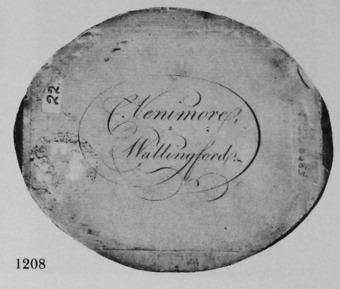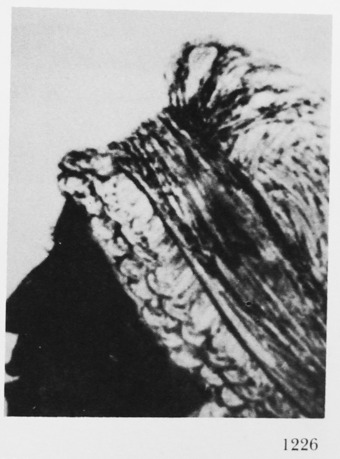Venimore, Christopher (McKechnie Section 3)
Recorded by Jackson (Dictionary), who mentions a profile of a cleric, painted in dead black on flat glass, c. 1778. Another profile (illustrated), of an elderly woman, dates possibly from as late as 1800. If Jackson's date of 1778 is correct (and not an error for 1798), then these two silhouettes were painted twenty-two years apart. On his trade label (illustrated) Venimore does not mention painting profiles; the wording does not specify his trade (or trades) and is typical of the labels which would have been used by, say, a maker of looking-glasses or a cabinet maker of the period. The address (simply `Wallingford') suggests his town of residence rather than a town visited by an itinerant artist. In the late eighteenth century Wallingford could not have provided a silhouette artist with a permanent means of livelihood, and would probably not have attracted travelling profilists. The wording of the label recorded by
Jackson (`C. Venimore, Wallingford') corresponds with that of the illustrated label.
The style of the illustrated profile on convex glass (the only profile by Venimore currently available) is comparable with, though slightly inferior to, that of O'Reilly (q.v.). Only the sitter's face is painted in dead black; almost all the clothing is shown in slight transparency, mainly by brushwork (apparently against a background of thinned wash, though a close examination shows use of the needle for high-lighting). The shape of the arm is defined by shading; the back of the arm does not form the line of the back of the profile, as was the custom of most silhouette artists, but is set well in away from it. There is also a suggestion of a second line at the bust-line termination, giving the arm almost a three-dimensional appearance.
Ills. 1207, 1208, 1226

Unknown woman
Silhouette painted on glass
? c. 1800
3 2 ½ in./77 x 64mm.
Trade label
Frame: oval, hammered brass
By courtesy of H. J. Benjamin

Trade Label of C. Venimore, from the silhouette illustrated in 1207.
By courtesy of H. J. Benjamin
DETAIL

Woman’s indoor cap.
Detail from a silhouette by C. Venimore. Compare this with the detail (1225) from a silhouette by O’Reilly. (1207)
By courtesy of H. J. Benjamin
